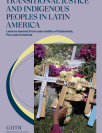30 Nov 2021
Transitional justice mechanisms have not always properly recorded the relevant experiences of indigenous peoples, such as their strategies for coping with violence and oppression. Consequently, most of the mechanisms implemented have not adequately linked past violations with continuing marginalization in the present.
However, transitional justice is dynamic and has been gradually incorporating more effective practices to reflect Indigenous experiences. At times, it has been transformed in response to interventions and adaptations by Indigenous communities and thanks to the growing international recognition of Indigenous peoples’ rights.
The report Transitional Justice and Indigenous Peoples in Latin America: Lessons Learned from Guatemala, Peru, and Colombia shows both the limitations and possibilities for constructive interaction between the field of transitional justice and the normative framework of indigenous rights. Protracted armed conflicts in Criollo (mixed heritage) States gave rise to generic transitional justice experiences, devoid of Indigenous approaches; but in their application, the instruments of truth, justice, and reparation encountered the specificity of Indigenous experiences and rights and had to be transformed in varying degrees. Broadening the field of transitional justice potentially includes the understanding of, and action on, the continuing territorial dispossession and harassment of Indigenous peoples.
The cases examined call for decisively integrating the indigenous peoples' rights framework and indigenous leadership within transitional justice, decolonizing its approaches, broadening its historical perspective, and consolidating its capacity to prefigure profound political transformations in states and their economic models.
Read the report here.






